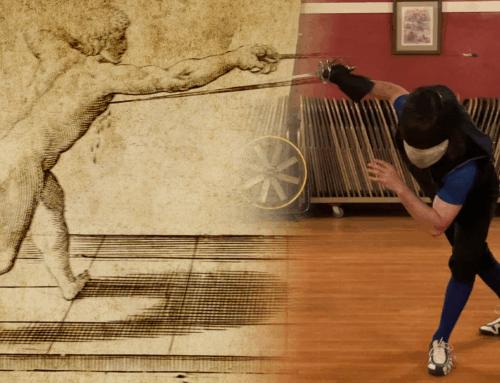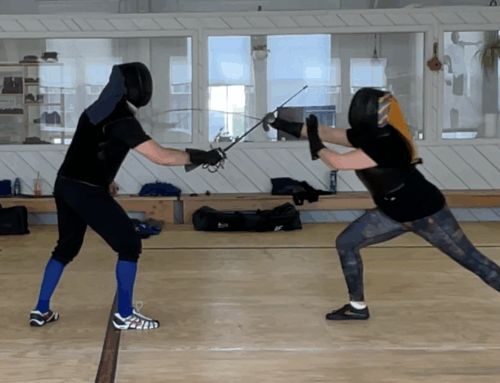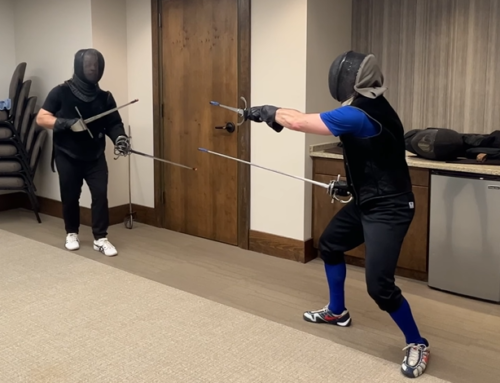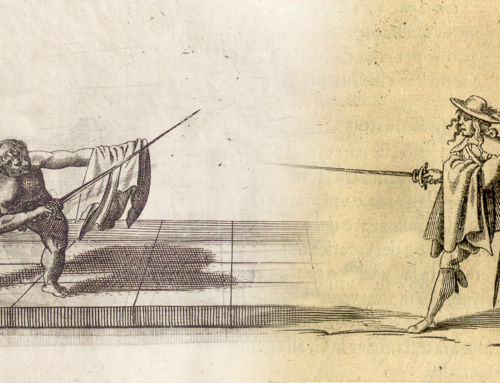It’s Measure month in my Back to Basics of Italian Rapier class with the goal of defining and understanding each measure, some basic rules to follow when in each measure, and some example plays or tactics to be used in each measure.
We’re kicking things off with Out of Measure, which is perhaps a very underappreciated measure — which I’ll get to later in the post. But first, let’s look at some more general thoughts about measure.
The Basics of Measure
First, since it’s the first week of the Measure month, let’s define measure (or misura in Italian).
In it’s essence, measure is the distance you need to cover to strike your opponent. Measure is also the distance your opponent needs to cover to strike you.
To be in measure means to be able to strike your opponent. To be out of measure means to be unable to strike your opponent. Typically, this is defined by striking with a firm-footed lunge, but we can expand this a bit to include passing-lunges which can sometimes add a few extra inches to an attack.
It’s important to note that not everyone’s measure is equal. Overall height, arm reach, blade length, and lunge length all play into whether you or your opponent are in measure. A taller fencer with a long blade will be in measure before a shorter fencer is. This is obviously problematic for the shorter fencer, but it’s not an insurmountable problem.
Measure, specifically, is the distance your weapon needs to travel to strike it’s target. So you may be in misura larga in terms of striking your opponent’s body, but stretta to strike their hand. We’ll get into those measures at later blog installments.
My buddy Arik Mendelevitz (of Fool of Swords) likes to also break measure down by an offensive measure and defensive measure. He defines your offensive measure by the placement of your back foot and your defensive measure by the placement of your front foot.
We see this play out in terms of a normal firm-footed lunge vs. a lunge that has a gaining step. With the gaining step, your offensive measure is now closer compared to a normal firm-footed lunge, but your defensive measure hasn’t changed since your targets aren’t any closer to your opponent’s weapons.
In the late-Renaissance Italian school of swordsmanship we see the following measures described:
- Out of Measure. You can’t strike your opponent without taking an advancing step first.
- Larga. Wide measure. The distance where a strike to the target requires an advance of the front foot (step-lunge).
- Stretta. Narrow measure. The distance where a strike to the target requires no movement of the feet (leaning-lunge).
- Perfeta (perfect measure). This is unique to Alfieri and is defined as being able to strike your opponent without over-stretching your body — so a moderate lunge and not a very deep lunge. It lays between stretta and larga.
Some modern schools of rapier, such as Academie Duello, also have expanded the taxonomy of measure to include two more measures:
- Strettisimma. Narrowest measure. “The distance where a strike to the target will hit even with a retreating step.”
- Larghissima. Widest measure. “The distance where a strike to the target requires a passing step.”
I find these two measures useful for teaching different tactical options with students even if they’re not found in the works of Fabris, Alfieri, Capoferro, Giganti, etc.
(NOTE: If anyone has come across those two measures in period sources, please let me know where! I’d love to see it).
OK, onto Out of Measure!
Why Out of Measure is Underappreciated
At the start of this blog, I talked about how I thought out of measure was an underappreciated measure. And that’s because so many fencers ignore it! Too many fencers (and I’ve been guilty of this myself) start off already in measure.
Often times this is because folks think this will make them strike their opponent faster. This is very much the case with shorter fencers who know they need to cross “no-man’s land” and weather a storm of attacks from their taller opponent, so they start off closer to “get through it” quicker.
And sure, if we used a timer, one could get into measure faster this way. But it’s not about overall time that matters and starting off too close puts one’s life (or bout victory, nowadays) on the line. It also turns bouts more into quick-draw gunslinging than actual fencing.
So please, for the love of your preferred-deity or lack thereof, start out of measure.
Other benefits of being out of measure:
- You’re safe from attack
- You have time to analyze your opponent
- You can observe how they move
- You can observe how long their blade is
- You can observe their temperament as they approach or hold their ground
Out of Measure & the True Fight
The True Fight is the aspect of fencing where you’re seeking control of your opponent’s weapon. You move forward if you have control and move back & seek control if you’ve lost control. There’s also no deceit (no feints) in the True Fight.
(I created a True Fight text-based game.
You can play Lvl 1 of the True Fight here.)
With this in mind, we have three general scenarios we run into when we’re out of measure, and some simple responses. If our opponent…
- Retreats.
- Hold your ground & wait for them to approach
- Or approach carefully
- Doesn’t move.
- Find their blade and approach
- Moves forward.
- Find their blade and hold your ground
- Find their blade and also step forward
Stepping forward after finding your opponent’s blade while they step forward is a great way for shorter fencers to get in measure much quicker while also catching your opponent off guard.
Blade Actions from Out of Measure
From out of measure, all blade actions are almost entirely done by taking counterpostures.
While approaching from out of measure, you’ll want to utilize the cavazione and it’s variants to keep or gain control over your opponent’s weapon.
Also when approaching from out of measure, it’s important to lead with your sword to seek the finding before taking an advancing step. As always, sword leads the body and this is still the case when we’re moving from out of measure into initial blade engagement.
As you seek to find their blade, if your opponent…
- Does nothing.
- Finish the finding and step forward, letting your body catch up to your blade
- Performs a cavazione (disengage) to find your weapon on the opposite line
- Perform a contracavazione (counter-disengage) and then approach.
Reaching out like this can also probe to see how your opponent will react to you finding their blade and is very low-risk recon.
Feints from Out of Measure
Feints are almost useless from out of measure, according to Alfieri. The idea being that the point of a feint is to gain a tempo in which to strike your opponent, but if you’re out of measure, you can’t really strike them in that tempo that you gain.
However, you can learn how your opponent will react and if they realize you can’t strike them from out of measure.
You can also feint while stepping from out of measure into initial blade engagement to gain a tempo that you can then either use to get into a closer measure or to strike.
Class Video
Here’s a recording of the class. It’s more or less what’s written out in this blog post, plus a strength/conditioning routine in the second half of the class.
DONATIONS: Classes are 100% free, however, if you find these sessions useful, please consider a small donation so I can continue to produce rapier & other historical martial arts content. Donate at https://www.paypal.me/thetavernknight










